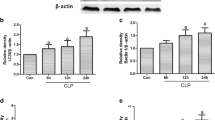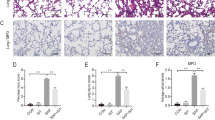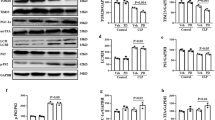Abstract
Objective
To investigate protective effect of Cordyceps sinensis (CS) through autophagy-associated adenosine monophosphate-activated protein kinase (AMPK)/mammalian target of rapamycin (mTOR) signaling pathway in acute kidney injury (AKI)-induced acute lung injury (ALI).
Methods
Forty-eight male Sprague-Dawley rats were divided into 4 groups according to a random number table, including the normal saline (NS)-treated sham group (sham group), NS-treated ischemia reperfusion injury (IRI) group (IRI group), and low- (5 g/kg·d) and high-dose (10 g/kg·d) CS-treated IRI groups (CS1 and CS2 groups), 12 rats in each group. Nephrectomy of the right kidney was performed on the IRI rat model that was subjected to 60 min of left renal pedicle occlusion followed by 12, 24, 48, and 72 h of reperfusion. The wet-to-dry (W/D) ratio of lung, levels of serum creatinine (Scr), blood urea nitrogen (BUN), inflammatory cytokines such as interleukin- β and tumor necrosis factor- α, and biomarkers of oxidative stress such as superoxide dismutase, malonaldehyde (MDA) and myeloperoxidase (MPO), were assayed. Histological examinations were conducted to determine damage of tissues in the kidney and lung. The protein expressions of light chain 3 II/light chain 3 I (LC3-II/LC3-I), uncoordinated-51-like kinase 1 (ULK1), P62, AMPK and mTOR were measured by Western blot and immunohistochemistry, respectively.
Results
The renal IRI induced pulmonary injury following AKI, resulting in significant increases in W/D ratio of lung, and the levels of Scr, BUN, inflammatory cytokines, MDA and MPO (P<0.01); all of these were reduced in the CS groups (P<0.05 or P<0.01). Compared with the IRI groups, the expression levels of P62 and mTOR were significantly lower (P<0.05 or P<0.01), while those of LC3-II/LC3-I, ULK1, and AMPK were significantly higher in the CS2 group (P<0.05 or P<0.01).
Conclusion
CS had a potential in treating lung injury following renal IRI through activation of the autophagy-related AMPK/mTOR signaling pathway in AKI-induced ALI.
Similar content being viewed by others
References
Zuk A, Bonventre JV. Acute kidney injury. Annu Rev Med 2016;67:293–307.
Haschler TN, Horsley H, Balys M, Anderson G, Taanman JW, Unwin RJ, et al. Sirtuin 5 depletion impairs mitochondrial function in human proximal tubular epithelial cells. Sci Rep 2021;11:15510.
Basu RK, Wheeler DS. Kidney-lung cross-talk and acute kidney injury. Pediatr Nephrol 2013;28:2239–2248.
Faubel S, Edelstein CL. Mechanisms and mediators of lung injury after acute kidney injury. Nat Rev Nephrol 2016;12:48–60.
Long H, Qiu X, Cao L, Liu G, Rao Z, Han R. Toxicological safety evaluation of the cultivated Chinese cordyceps. J Ethnopharmacol 2021;268:113600.
Tan L, Song X, Ren Y, Wang M, Guo C, Guo D, et al. Anti-inflammatory effects of cordycepin: a review. Phytother Res 2020.
Sun T, Dong W, Jiang G, Yang J, Liu J, Zhao L, et al. Cordyceps militaris improves chronic kidney disease by affecting TLR4/NF- κ B redox signaling pathway. Oxid Med Cell Longev 2019;2019:7850863.
Fu S, Lu W, Yu W, Hu J. Protective effect of Cordyceps sinensis extract on lipopolysaccharide-induced acute lung injury in mice. Biosci Rep 2019;39:BSR20190789.
Cao W, Li J, Yang K, Cao D. An overview of autophagy: mechanism, regulation and research progress. Bull Cancer 2021;108:304–322.
Carling D. AMPK signalling in health and disease. Curr Opin Cell Biol 2017;45:31–37.
Li Y, Chen Y. AMPK and autophagy. Adv Exp Med Biol 2019;1206:85–108.
Kim J, Kundu M, Viollet B, Guan KL. AMPK and mTOR regulate autophagy through direct phosphorylation of ULK1. Nat Cell Biol 2011;13:132–141.
Kaushal GP, Shah SV. Autophagy in acute kidney injury. Kidney Int 2016;89:779–791.
Bhatia D, Chung KP, Nakahira K, Patino E, Rice MC, Torres LK, et al. Mitophagy-dependent macrophage reprogramming protects against kidney fibrosis. JCI Insight 2019;4:e132826.
Qu L, Chen C, Chen Y, Li Y, Tang F, Huang H, et al. High-mobility group box 1 (HMGB1) and autophagy in acute lung injury (ALI): a review. Med Sci Monit 2019;25:1828–1837.
Meng L, Zhao X, Zhang H. HIPK1 interference attenuates inflammation and oxidative stress of acute lung injury via autophagy. Med Sci Monit 2019;25:827–835.
Zhan L, Zhang Y, Su W, Zhang Q, Chen R, Zhao B, et al. The roles of autophagy in acute lung injury induced by myocardial ischemia reperfusion in diabetic rats. J Diabetes Res 2018;2018:5047526.
Takakura K, Ito S, Sonoda J, Tabata K, Shiozaki M, Nagai K, et al. Cordyceps militaris improves the survival of Dahl salt-sensitive hypertensive rats possibly via influences of mitochondria and autophagy functions. Heliyon 2017;3:e00462.
Yuan M, Tang R, Zhou Q, Liu K, Xiao Z, Pouranan V. Effect of Cordyceps sinensis on expressions of HIF-1 α and VEGF in the kidney of rats with diabetic nephropathy. J Centr South Univ (Med Sci, Chin) 2013;38:448–457.
Devarajan P. Update on mechanisms of ischemic acute kidney injury. J Am Soc Nephrol 2006;17:1503–1520.
Ozdulger A, Cinel I, Koksel O, Cinel L, Avlan D, Unlu A, et al. The protective effect of N-acetylcysteine on apoptotic lung injury in cecal ligation and puncture-induced sepsis model. Shock 2003;19:366–372.
Deng JS, Jiang WP, Chen CC, Lee LY, Li PY, Huang WC, et al. Cordyceps cicadae mycelia ameliorate cisplatin-induced acute kidney injury by suppressing the TLR4/NF-κ B/MAPK and activating the HO-1/Nrf2 and Sirt-1/AMPK pathways in mice. Oxid Med Cell Longev 2020;2020:7912763.
Sato Y, Yanagita M. Immune cells and inflammation in AKI to CKD progression. Am J Physiol Renal Physiol 2018;315:F1501–F1512.
Kher A, Kher V. Prevention and therapy of AKI in Asia: a big challenge. Semin Nephrol 2020;40:477–488.
Singbartl K. Renal-pulmonary crosstalk. Contrib Nephrol 2011;174:65–70.
Teixeira JP, Ambruso S, Griffin BR, Faubel S. Pulmonary consequences of acute kidney injury. Semin Nephrol 2019;39:3–16.
Wang HP, Liu CW, Chang HW, Tsai JW, Sung YZ, Chang LC. Cordyceps sinensis protects against renal ischemia/reperfusion injury in rats. Mol Biol Rep 2013;40:2347–2355.
Li X, Zhou Y, Zhang X, Cao X, Wu C, Guo P. Cordycepin stimulates autophagy in macrophages and prevents atherosclerotic plaque formation in ApoE(-/-) mice. Oncotarget 2017;8:94726–94737.
Kaushal GP, Chandrashekar K, Juncos LA, Shah SV. Autophagy function and regulation in kidney disease. Biomolecules 2020;10:100.
Yang HX, Wang P, Wang NN, Li SD, Yang MH. Tongxinluo ameliorates myocardial ischemia-reperfusion injury mainly via activating parkin-mediated mitophagy and downregulating ubiquitin-proteasome system. Chin J Integr Med 2021;27:542–550.
Jiang M, Liu K, Luo J, Dong Z. Autophagy is a renoprotective mechanism during in vitro hypoxia and in vivo ischemia-reperfusion injury. Am J Pathol 2010;176:1181–1192.
Decuypere JP, Ceulemans LJ, Agostinis P, Monbaliu D, Naesens M, Pirenne J, et al. Autophagy and the kidney: implications for ischemia-reperfusion injury and therapy. Am J Kidney Dis 2015;66:699–709.
Glick D, Barth S, Macleod KF. Autophagy: cellular and molecular mechanisms. J Pathol 2010;221:3–12.
Liu L, Feng D, Chen G, Chen M, Zheng Q, Song P, et al. Mitochondrial outer-membrane protein FUNDC1 mediates hypoxia-induced mitophagy in mammalian cells. Nat Cell Biol 2012;14:177–185.
Sánchez-Martín P, Saito T, Komatsu M. p62/SQSTM1: ‘Jack of all trades’ in health and cancer. FEBS J 2019;286:8–23.
Alers S, Löffler AS, Wesselborg S, Stork B. Role of AMPK-mTOR-Ulk1/2 in the regulation of autophagy: cross talk, shortcuts, and feedbacks. Mol Cell Biol 2012;32:2–11.
Shi B, Ma M, Zheng Y, Pan Y, Lin X. mTOR and Beclin1: two key autophagy-related molecules and their roles in myocardial ischemia/reperfusion injury. J Cell Physiol 2019;234:12562–12568.
Yu YH, Zhang P, Wang CL, Liu JG, Li P, Zhang DW. Panax quinquefolium saponin optimizes energy homeostasis by modulating AMPK-activated metabolic pathways in hypoxia-reperfusion induced cardiomyocytes. Chin J Integr Med 2021;27:613–620.
Chun Y, Kim J. AMPK-mTOR signaling and cellular adaptations in hypoxia. Int J Mol Sci 2021;22:9765.
Qi W, Zhou X, Wang J, Zhang K, Zhou Y, Chen S, et al. Cordyceps sinensis polysaccharide inhibits colon cancer cells growth by inducing apoptosis and autophagy flux blockage via mTOR signaling. Carbohydr Polym 2020;237:116113.
Wang Y, Liu Z, Shu S, Cai J, Tang C, Dong Z. AMPK/mTOR signaling in autophagy regulation during cisplatin-induced acute kidney injury. Front Physiol 2020;11:619730.
Yang T, Feng X, Zhao Y, Zhang H, Cui H, Wei M, et al. Dexmedetomidine enhances autophagy via α2-AR/AMPK/mTOR pathway to inhibit the activation of NLRP3 inflammasome and subsequently alleviates lipopolysaccharide-induced acute kidney injury. Front Pharmacol 2020;11:790.
Tu Y, Sun W, Chen DP, Wan YG, Wu W, Yao J. Molecular mechanisms of autophagy in regulating renal aging and interventional effects of Chinese herbal medicine. China J Chin Mater Med (Chin) 2016; 41:3914–3918.
Zhang X, Zheng J, Yan Y, Ruan Z, Su Y, Wang J, et al. Angiotensin-converting enzyme 2 regulates autophagy in acute lung injury through AMPK/mTOR signaling. Arch Biochem Biophys 2019;672:108061.
Wang Y, Zhang J, Bo J, Wang X, Zhu J. Hydrogen-rich saline ameliorated LPS-induced acute lung injury via autophagy inhibition through the ROS/AMPK/mTOR pathway in mice. Exp Biol Med (Maywood) 2019;244:721–727.
Aboutaleb N, Jamali H, Abolhasani M, Pazoki Toroudi H. Lavender oil (Lavandula angustifolia) attenuates renal ischemia/reperfusion injury in rats through suppression of inflammation, oxidative stress and apoptosis. Biomed Pharmacother 2019;110:9–19.
Hadj Abdallah N, Baulies A, Bouhlel A, Bejaoui M, Zaouali MA, Ben Mimouna S, et al. Zinc mitigates renal ischemia-reperfusion injury in rats by modulating oxidative stress, endoplasmic reticulum stress, and autophagy. J Cell Physiol 2018;233:8677–8690.
Ramesh G, Reeves WB. Inflammatory cytokines in acute renal failure. Kidney Int Suppl 2004:S56-S61.
Kielar ML, John R, Bennett M, Richardson JA, Shelton JM, Chen L, et al. Maladaptive role of IL-6 in ischemic acute renal failure. J Am Soc Nephrol 2005;16:3315–3325.
Author information
Authors and Affiliations
Contributions
Wang RL designed the experimental scheme, conceived and wrote the manuscript. Shen SH collected materials and participated in the experimental process. Jian LY made the first revision of the manuscript. Liu SH contributed to manuscript drafting. Guo HH submitted the final manuscript. Yuan Q, Huang JS and Chen PH participated in the experimental process. Huang RF put forward theoretical ideas and modified the final manuscript. All authors participated in this article and finally approved the submitted and published version.
Corresponding author
Ethics declarations
The authors declare that the research was conducted in the absence of any commercial or financial relationships that could be construed as a potential conflict of interest.
Additional information
Supported by the National Natural Science Foundation of China (No. 81460682), the Natural Science Foundation of Guangdong Province (No. 2020A1515010566), and the Shenzhen Foundation of Science and Technology Research and Development (No. JCYJ20190809102413156)
Rights and permissions
About this article
Cite this article
Wang, Rl., Liu, Sh., Shen, Sh. et al. Protective Mechanism of Cordyceps sinensis Treatment on Acute Kidney Injury-Induced Acute Lung Injury through AMPK/mTOR Signaling Pathway. Chin. J. Integr. Med. 29, 875–884 (2023). https://doi.org/10.1007/s11655-023-3593-4
Accepted:
Published:
Issue Date:
DOI: https://doi.org/10.1007/s11655-023-3593-4




